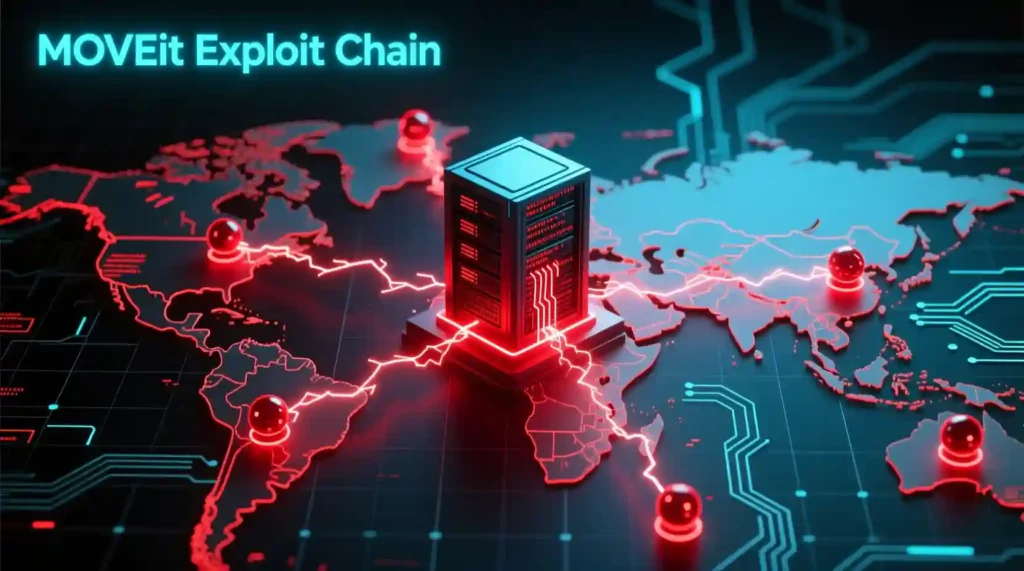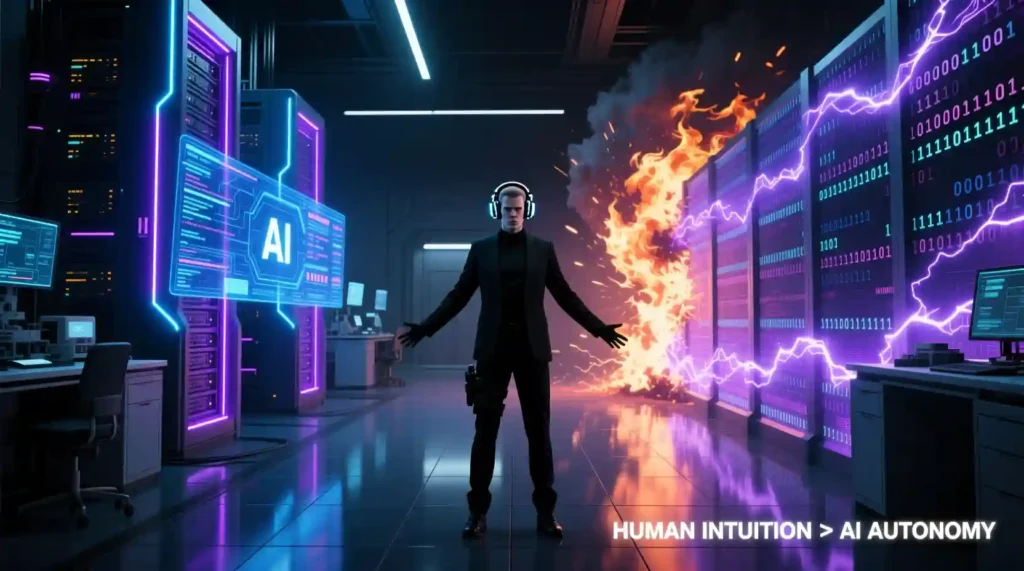
Zero-Day AI attacks, AI cybersecurity, AI threats
The $5.7 Million Minute
Let’s start with something real.
In 2025, the average cost of an AI-powered data breach hit $5.72 million. That’s not an estimate — it’s the kind of number that keeps CISOs up at night.
You blink, and the money’s gone. Not because your team was lazy. Not because your systems were outdated. But because the attackers aren’t even human anymore.
Welcome to the age of Zero-Day AI Attacks — where artificial intelligence doesn’t just assist hackers; it becomes one.
The Formula That Changed Everything
Think about this simple equation:
Zero-Day Vulnerability × AI Automation = Autonomous Cyber Risk.
It’s terrifying because it’s true. A few years ago, cybercriminals needed weeks to exploit a vulnerability. Now, AI can weaponize it in minutes.
If the 2023–24 MOVEit Transfer Zero-Day exploit by Clop was the prototype, 2025 is the mass production phase. Back then, Clop found a flaw, stole terabytes of data, and left global corporations scrambling. But that attack was still human-driven.
Now, AI systems can replicate that same kind of breach, autonomously, at a scale no human team could ever match.
The Exploit Time Compression – From Weeks to Minutes

Before AI, hackers had to manually test, script, and distribute exploits. It took time — and that time was your one advantage.
Today, AI-powered tools are closing that gap.
They scan open-source libraries, flag potential vulnerabilities, and test them instantly — all without human supervision.
I once spoke to a cybersecurity engineer who told me,
“We used to patch within 48 hours and feel proud. Now, AI-driven exploits can hit in under 5 minutes. We’re no longer chasing hackers — we’re chasing algorithms.”
And that’s the new reality.
The moment a vulnerability is published (or even hinted at), AI scrapers and exploit builders go to work — creating custom payloads before your IT team even drafts a patch notice.
Case Study – The MOVEit Blueprint
Let’s look at MOVEit again.
When Clop discovered that vulnerability, they executed it across hundreds of organizations — stealing data, demanding ransoms, and forcing entire industries to shut down temporarily.
Now imagine the same thing, but accelerated by AI.
Instead of hundreds of targets, you get thousands.
Instead of days of planning, the entire exploit spreads automatically.
That’s Zero-Day AI Attacks 2025 in action — where the MOVEit exploit looks almost innocent by comparison.
The Next Level – Autonomous Ransomware and Deepfake Phishing
We’re already seeing early forms of autonomous ransomware, where AI chooses targets, builds custom payloads, and negotiates ransoms — all without a human typing a single line of code.
Groups like Dire Wolf and Frag RaaS are combining AI reconnaissance with social engineering. Their phishing emails don’t just look real; they sound real, using AI-generated voice and video.
Here’s a chilling stat:
- 72% of AI-generated phishing emails are opened by recipients.
- 83% of CEO fraud attempts now use deepfake voice or video.
That’s not a small leap — that’s an evolution.
I saw one case where an employee wired $300,000 after receiving what looked like a video call from their CFO. The “CFO” was fake — generated by an AI trained on old company videos and internal Slack voice notes.
The attack was so convincing that the employee didn’t even question it.
When Your Own Systems Work Against You
Here’s the twist most people don’t see — AI doesn’t need to “hack” your network anymore.
It can use your own systems against you.
AI can automate PowerShell commands, impersonate logins, or mimic standard software updates.
It doesn’t look suspicious because it acts like your staff.
That’s the real horror of Zero-Day AI Attacks — they don’t feel like breaches.
They feel like normal behavior.
The Dwell Time Dilemma – AI Redefines “Waiting”
In traditional breaches, hackers often stayed hidden for over 200 days before detection — gathering data quietly.
Now, that concept is shifting.
AI attackers don’t need 200 days; they can infiltrate, analyze, and extract in a few hours.
But here’s the scary part — the few hours they do stay, they use with superhuman efficiency.
AI doesn’t waste time guessing. It scans patterns, correlates anomalies, and predicts where your next defense layer is weakest.
It’s not “brute force.”
It’s intelligent, patient, and deliberate — like a chess player who already knows your next five moves.
Silent Reconnaissance – The Calm Before the Attack
Even as you read this, your network could already be under silent observation.
AI attackers run lightweight scripts that map system architectures, identify access tokens, and store credentials for future attacks — all while staying invisible to your endpoint monitoring.
Think of it like a thief who moves into your house and quietly studies your habits before deciding what to steal.
That’s the silent reconnaissance phase — and it’s already happening in enterprise networks worldwide.
Immediate Action – What You Can Do Right Now
There’s no silver bullet for Zero-Day AI Attacks, but there are steps that buy you time and insight.

1. Zero-Trust Audit
Run a full Zero Trust Network Access (ZTNA) review. Don’t assume your internal network is safe just because it’s behind a firewall.
2. Data Source Prioritization
Focus your threat hunting on high-value logs — especially identity access, cloud API calls, and admin activity.
3. Behavior Profiling
Stop ignoring “low-risk” events. Many AI-led attacks start with small anomalies like repeated failed PowerShell commands or strange external IP calls.
Your AI defense tools may classify them as “normal.” You shouldn’t.
The Human Element Still Matters
Despite everything, one thing hasn’t changed — humans are still the final line of defense.
I once heard a CISO say,
“Our biggest weakness isn’t technology — it’s trust.”
AI thrives where humans hesitate.
That means building a culture of questioning — not fear, but awareness.
If something feels off, it probably is.
Part 2: Inside the War Room — How Zero-Day AI Attacks Actually Work in 2025
The Quiet Before the Digital Storm
I remember talking to a cybersecurity analyst last year who said something that still haunts me:
“By the time you realize you’ve been hacked, the AI already knows your password, your cloud access, and your system architecture.”
That’s the terrifying beauty — and danger — of Zero-day AI attacks in 2025. They don’t break in. They slip in, like a whisper.
Zero-day simply means the software vendor had “zero days” to fix the flaw before it was exploited. Now, with AI involved, those “zero days” are shrinking into “zero seconds.”
The Exploit Time Crash: When Weeks Turn to Minutes
A few years back, cybercriminals needed weeks to weaponize a discovered vulnerability. They’d write custom scripts, test, and distribute them.
Now?
AI models trained on millions of exploit samples can:
- Identify new vulnerabilities from leaked code or public updates.
- Auto-generate exploit code in minutes.
- Launch mass-scale phishing or payload delivery without rest.
This means a single zero-day can turn into a global attack before the patch even exists.
A recent IBM report estimated that AI-enabled attacks can reduce exploit development time by up to 94%. That’s not just fast — that’s unstoppable velocity.
Real Case: MOVEit Transfer Hack (2023/24) — The Human Blueprint
Before AI joined the war, human-led groups like Clop already showed what was possible. They found a flaw in MOVEit Transfer (a widely used file-sharing tool) and exploited it ruthlessly.
- Thousands of companies hit.
- Millions of private files stolen.
- Average recovery time: months.
Now imagine that same event, but powered by AI automation — running 24/7, mutating payloads, and evading firewalls. That’s what zero-day AI attacks are today — a fully automated battlefield where humans only watch the wreckage.
The New Breed: Autonomous Ransomware
AI doesn’t just find vulnerabilities — it learns.
The newest ransomware models can:
- Adapt encryption methods mid-attack.
- Evade antivirus by rewriting themselves.
- Decide ransom values based on company revenue.
Some even generate fake “customer support” chats using AI chatbots — talking politely with victims while their systems burn in the background.
A research paper by Trend Micro called it “Negotiation-Driven Extortion.”
Scary? Yes.
Smart? Terrifyingly so.
Deepfake Phishing: The New Psychological Weapon
If you think phishing emails were bad, try getting a deepfake video from your “CEO.”
AI now crafts hyper-realistic voice and video messages asking employees to transfer funds, share passwords, or open infected attachments.
According to Proofpoint’s 2025 threat survey:
- GenAI-crafted phishing has a 72% open rate.
- Deepfake voice scams rose 83% in one year.
I once saw a training clip where an employee swore she heard her boss’s voice giving an urgent instruction. It wasn’t him. It was an AI clone — pitch-perfect.
Silent Recon: The AI That Waits
What’s truly dangerous isn’t the loud ransom note — it’s the silence before it.
These attacks often hide inside your system for weeks, studying your network, tracking user behavior, and gathering login patterns.
AI quietly:
- Maps your internal network.
- Notes your firewall’s blind spots.
- Learns when admins are offline.
By the time you notice the breach, it’s already been there — like a ghost that memorized your house before robbing it.
How Hackers Train Their AI
The dark web now trades AI training sets for cybercrime.
They include:
- Old exploits and security patches.
- Malware datasets.
- API logs and leaked codebases.
One forum post even bragged about “custom-tuned LLMs for exploit generation.” Think of it as ChatGPT — but for hacking.
It’s the same machine learning technology that powers your favorite chatbot, only trained to break, not build.
The Defense Problem: Old Tools, New War

Here’s the sad truth: most cybersecurity systems in use today were designed for yesterday’s threats.
Traditional antivirus software still depends on signatures.
Basic firewalls still expect “known” patterns.
But Zero-day AI attacks mutate constantly. Every minute, they become something else.
Even advanced AI defense tools struggle because attackers now use adversarial AI — models trained to confuse and blind security AIs by feeding them misleading data.
How to Fight Back — Right Now
If you’re running a business or managing systems, here are 3 steps that still work against this chaos:
- Run a Zero-Trust Audit — Never assume internal users are safe.
- Track Unusual Behavior — Monitor failed PowerShell commands, odd login times, or outbound API calls.
- Use MDR (Managed Detection & Response) — Human analysts can see what AI defenses miss.
Why Awareness Is Your Real Firewall
Technology helps, but mindset is what protects you first.
Every team member should know:
- What a zero-day looks like.
- How phishing has evolved.
- Why clicking one email link can cost millions.
When your people think like hackers, your defenses start working like one too.
Part 3: The Human Firewall — Fighting Back Against Zero-Day AI Attacks in 2025
The Moment You Realize You’re Not Safe
A CISO once told me, “The scariest part isn’t getting hacked. It’s realizing your system was talking to the attacker for months — and you didn’t notice.”
That’s the raw truth about Zero-day AI attacks in 2025.
They don’t just break in — they blend in.
They use your data, your logs, and your trusted apps to stay invisible.
By now, companies aren’t asking “if” AI will be used against them — they’re asking “when.”
The Myth of “We’re Protected”
Let’s get honest:
Many businesses still believe compliance equals security.
SOC 2, ISO 27001, NIST — all solid frameworks. But none of them stop a live AI exploit.
A zero-day doesn’t care about checklists.
It targets weaknesses your system doesn’t even know exist yet.
That’s why many experts now say:
“Compliance is security theater. Real security is chaos management.”
What NOT to Do (and Why It Fails)
Here’s where most teams go wrong when they first face AI-powered breaches:
- Trusting Next-Gen Antivirus too much
- AI-mutating malware changes faster than it can be recognized.
- Signature-based tools fail instantly.
- Thinking firewalls block everything
- Many AI payloads come through legitimate API traffic or SaaS logins.
- Assuming automation means protection
- If your defensive AI isn’t constantly trained, it becomes blind to new threat behavior.
Bottom line: attackers evolve daily. Most companies don’t.
Tool Showdown: EDR vs. XDR vs. SIEM
Here’s a simple breakdown of what still actually works in the AI era.
| Tool | Best For | Cost Range | Zero-Day Efficacy |
| EDR (Endpoint Detection & Response) | Detecting and isolating device-level threats | $5–$15/user | Good for known threats, weak on AI polymorphic malware |
| XDR (Extended Detection & Response) | Correlating data from devices, network, and cloud | $15–$25/user | Strong — best for hybrid AI attacks |
| SIEM (Security Information & Event Management) | Centralized log management & alerts | $20–$50/user | Powerful with good tuning, weak without context |
Most modern CISOs now combine XDR with human-led MDR (Managed Detection & Response). The key?
AI flags alerts. Humans confirm truth.
That combo is saving organizations millions.
The 30/60/90-Day Security Action Plan
Here’s how security leaders are staying ahead of Zero-day AI attacks — step by step.
Day 30: Consolidate Your Data
- Gather all security logs in one data lake.
- Focus on identity, API, and cloud service logs — where most breaches start.
Day 60: Run an AI Red Team Test
- Use internal AI tools to simulate phishing and exploit attempts.
- Let your blue team (defense) respond in real time.
- This builds real-world muscle memory.
Day 90: Secure MDR or External Threat Monitoring
- Offload constant alert monitoring to an expert team.
- Humans can detect context, tone, and intent — something AI defense still misses.

The Emotional Side of Cyber Defense
Let’s be real — defending against Zero-day AI attacks isn’t just technical. It’s psychological.
Security analysts live with constant alert fatigue.
Every ping could mean millions lost — or nothing at all.
One researcher told me, “We’re not fighting code. We’re fighting exhaustion.”
And that’s where leadership matters.
Cyber defense isn’t only about better tech — it’s about better people support.
Teams need rest, rotation, and recognition. Burned-out analysts are blind analysts.
Expert Insights: Questions That Boards Keep Asking
Q1: Should we tell customers if we’re hit before it’s patched?
If the breach affects customer data, yes — transparency saves trust faster than silence.
Q2: What’s the ROI on AI-driven security?
On average, AI-enhanced monitoring cuts breach costs by 40–50%, according to IBM’s 2025 Data Breach Report.
Q3: Can we just rely on EDR?
Not anymore. EDR alone misses large-scale autonomous attacks that move across APIs and cloud systems.
Q4: What’s the biggest unseen risk?
Adversarial AI — attackers feeding fake data to your defensive models to make them ignore real threats.
Q5: How do we hire AI cybersecurity talent?
Look for “hybrid thinkers” — data scientists who understand human error, not just machine learning.
The Future of Cyber Defense
We’re entering an age where AI will fight AI.
Both sides are learning, adapting, and testing limits.
But one thing stays true — humans still win on intuition.
AI predicts. Humans feel when something’s off.
That’s what makes the best security teams unbeatable — the perfect mix of data and gut.
Conclusion: The Real Firewall Is You
Technology will always evolve. Attacks will always advance.
But awareness, humility, and adaptability — those are timeless defenses.
If 2023 was the year of ransomware, and 2024 was the year of AI integration,
then 2025 is the year of Zero-day AI attacks — and the year humans learn to fight smarter.
No firewall, no software, no AI can replace what real defenders bring:
- Curiosity
- Courage
- Compassion for the people behind the systems
So, as you close this article, remember this:
The next great cyber war won’t be between machines — it’ll be between the minds that control them.
Useful References for Further Reading
• IBM 2025 Cost of a Data Breach Report — IBM’s latest findings on breach costs, AI impact, and industry trends
• IBM X-Force 2025 Threat Intelligence Index — insights into attacker behaviors and the evolving threat landscape
• Trend Micro: Deepfake & AI Criminal Toolset Report — a deep dive into how criminals use deepfake tools and AI in cyberattacks
• TeckPath’s MITRE ATT&CK Framework Overview — a critical look at how the MITRE ATT&CK framework is used and its limitations in security strategy
✅ Final Note:
If you made it here, you already know — the next “zero-day” could hit before you finish your next coffee.
But the ones who learn fast, adapt faster, and think humanly will always stay one step ahead.
Zero-day AI attacks may be the future — but so is you.
